Funding has been secured to set up centres of excellence in maternal and child healthcare in Western Australia to build capacity across the State.
The national ‘closing the -gap’ initiative has brought Aboriginal and Torres Strait Islander disadvantage into sharp focus and highlighted the significant health disparities for Aboriginal women and children. The Aboriginal Community Controlled Health Sector, through its network of Aboriginal Community Controlled Health Services (ACCHS), provides essential primary healthcare to Aboriginal women and families within a culturally safe environment.
Western Australia is the largest Australian State, with an area of more than 2 500 000km2, a 12 500km coastline and a span of some 2400km from north to south, occupying a third of the Australian continent. These expansive distances, coupled with workforce shortages and a mining boom, present significant challenges to healthcare delivery. Nineteen ACHHSs across the State provide primary healthcare services to the Indigenous population of WA.
The Aboriginal Health Council of WA (AHCWA) received a one-off project grant from the Department of Health and Ageing (WA) to establish a maternal and child health program for ACCHSs. The funding was used to prepare the sector for the rollout of the Council of Australian Governments (COAG) Early Childhood initiatives and to develop models of excellence in maternal and child healthcare across the sector. The project was monitored by a steering committee, with representation from Department of Health and Ageing, Office for Aboriginal and Torres Strait Islander Health, Aboriginal Health Council of Western Australia, The Telethon Institute for Child Health Research and Kimberley Aboriginal Medical Services Council and supported by a technical advisory group, including a midwifery consultant, also the project leader/manager, a specialist obstetrician and a paediatrician with expertise in Aboriginal maternal and child health.
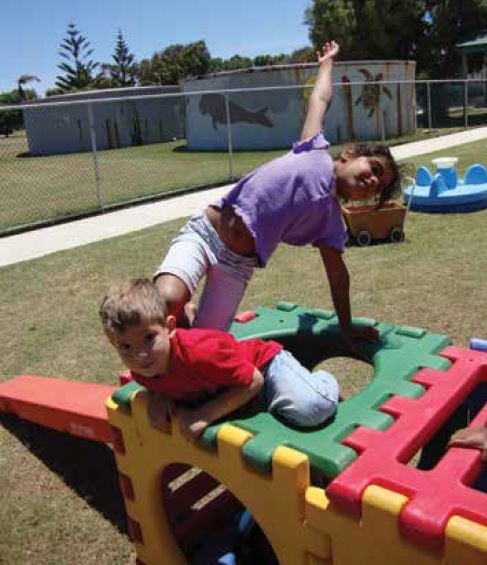
Codi and Manny play at Meekawaya, the local kindy for Aboriginal children in Geraldton.
Three project components
Funding of three ACCHSs
This was via a competitive funding round. The three ACCHSs had already demonstrated: high standards of clinical practice; commitment to become learning hubs; and the ability to build on existing services. The funding was to enable the ACCHSs to further develop an aspect of their maternal and child health program to respond to an identified unmet need. Each site identified specific local priorities and implemented targeted strategies to address specific objectives. These objectives included improving multi-agency care planning and coordination together with improving sexual and reproductive health options for teenagers.
‘Strengths and Needs’ analysis
This was commissioned by AHCWA to document a State-wide picture of the maternal and child health services provided by ACCHSs across WA. Achieving excellence in maternal and child healthcare requires information on current health-service delivery, identifying strengths as well as gaps in service provision. The analysis was undertaken by the Combined Universities Centre for Rural Health and provided valuable information for ACCHSs and ACHWA to compare the current delivery of services against the model of excellence. The 29 recommendations fit within the model of care developed by the project group, with the focus on the following broad themes:
- Models of care: maternal and child health, including guidelines, standards of care inclusive of continuous quality improvement and action research at local level to inform this process.
- Infrastructure: funding, communication and IT.
- Partnerships: integration and referral.
- Workforce: training and development.
- Health promotion.
Before the analysis, the services highlighted that comprehensive maternal and child health services require adequate resources and gaps in service provision reflect the complexities of care delivery, particularly in rural and remote settings. These concerns were noted by AHCWA Board members, with the Board reassuring services that their commitment to undertake the analysis ensured services would be further supported at regional planning forums and would be better prepared for the implementation and roll out of the COAG national partnership agreement in WA.5
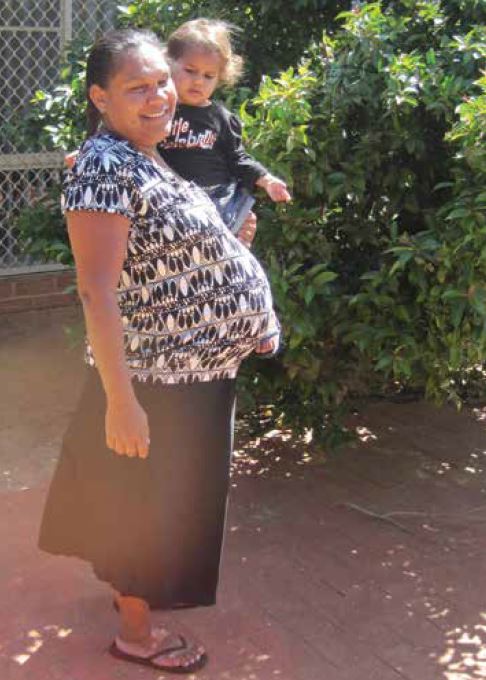
Natalie and Lila have accessed services at GRAMS.
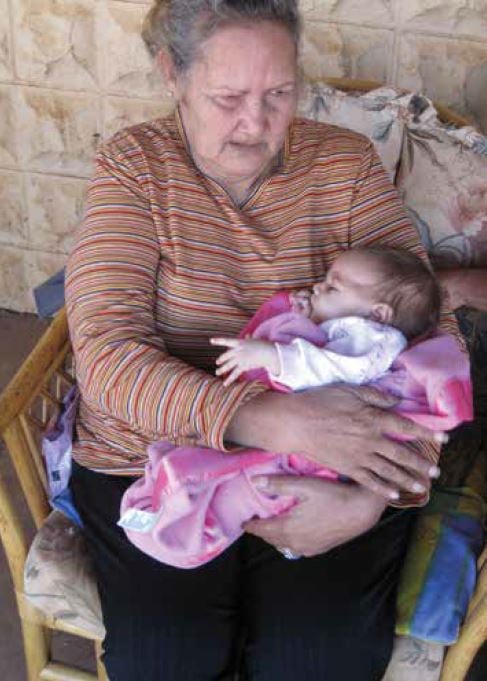
Raven Sky lives at Kardaloo Farm, a small Aboriginal community about 45 minutes drive from Mullewa, she is being held by her grandmother.
The maternal and child health model of care
The maternal and child health model of care was developed using a toolkit approach with the overall aim of supporting all primary care services to make a significant contribution towards COAG’s Indigenous Reform Agenda for Maternal and Child Health.5 The process led by the Technical Advisory Group was continuously informed by the ACCHSs to ensure the document provided support to implement safe, high-quality, evidence-based care within a foundation of cultural safety. Although specifically designed for use in the Aboriginal Health Care Sector the model is easily transferable to other areas of maternal and child health supporting the development of primary healthcare and the importance of service linkages with other stakeholders.
Funding for ACCHSs comes from a variety of sources and in addition to the complexity of short-term project funding, services are overburdened with separate and frequently duplicated reporting requirements. However, in order to build capacity, it was essential that services were able to capture the changes that the targeted funding and support achieved, to report on capacity building strategies and share learning across the sector. The method chosen to capture this activity, in line with a quality improvement and clinical governance process was the development of a maternal and child health dashboard providing a user-friendly method to benchmark activity and monitor performance against the model of excellence. The dashboard was adapted from a tool used to monitor the implementation of principles of clinical governance ‘on the ground’.6,7 Service managers, health professionals and fund holders using a visual ‘traffic light system’ received up-to-date information regarding resources, clinical activity, risk management issues and community engagement to enable early identification of issues of concern and ensure the overall goal to improve maternal and child health outcomes was on track.
The long-term value of the project will be evidenced by its ability to further develop capacity-building initiatives, provide learning opportunities and share expertise and best-practice knowledge, together with building on existing partnerships between ACCHSs and external stakeholders. This work has already commenced via a joint commitment to partnership by the AHCWA and Women and Newborns Health Service, WA Health. Both organisations have committed to working together with all providers to progress the recommendations of the Strengths and Needs Analysis and highlight the value of the maternal and child health model of care.
An Aboriginal Maternity Services Support Unit, funded as part of the COAG IECD program has been established at the Women’s and Newborns Health Service co-located on the site of King Edward Memorial Hospital, WA’s only tertiary maternity service. The strategic purpose of the unit is to build capacity and sustainability within services providing care to Aboriginal women and their newborns. The commitment of all agencies is clearly evident and it is hoped that this will ensure a significant improvement in the health and wellbeing of Aboriginal women and children in WA.
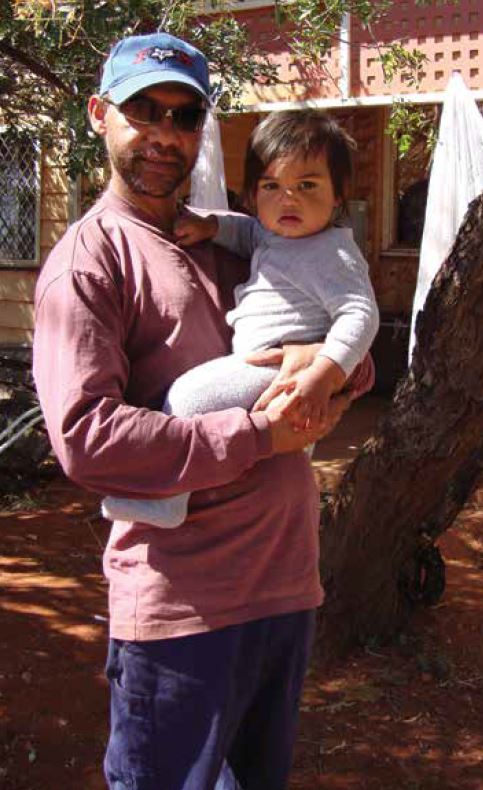
Brian and his father at Kardaloo farm.
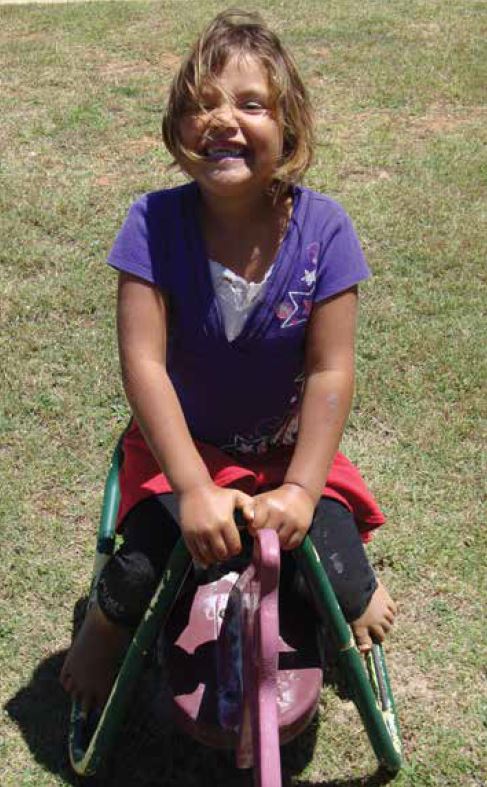
Sarah is playing at Meekawaya kindy.
Maternal and child health at Geraldton Regional Aboriginal Medical Service
Geraldton Regional Aboriginal Medical Service (GRAMS) hosts a maternal and child health team that provides care to Yamatji women and their families. The team consists of nine health professionals offering child health checks, childhood immunisations, specialist paediatric consultations, maternity care, audiology, paediatric physiotherapy and specialist gynaecological consultations. As part of this service, two midwives, who have recently been awarded ‘eligibility’ status, provide antenatal and postpartum care to approximately 160 women a year and childhood immunisation to families from Geraldton (a coastal regional centre 424km north of Perth), Mount Magnet (333km east of Geraldton) and another country town, Mullewa (92km east of Geraldton). The midwives and Aboriginal health workers provide the majority of care, working collaboratively with two visiting GP obstetricians who also provide intrapartum care at Geraldton Regional Hospital. The model is best described as midwifery-led shared care. Care is provided though drop-in clinics that are a ‘one-stop shop’. These are deliberate strategies designed to suit the spontaneous and sometimes infrequent nature in which Aboriginal women access health services. Access is facilitated through bulk-billing and the provision of transport. The majority of caregivers are female. Care is culturally safe and evidence based.2,3,4 Many of the social determinants of health are addressed to enable Aboriginal families to easily access high-quality healthcare.
GRAMS was one of the ACCHSs to receive funding as part of the excellence in maternal and child health project. These monies enabled GRAMS to employ an additional midwife to provide dedicated postpartum care and regularly visit the country town of Mount Magnet; purchase audiology equipment, a cardiotocograph and portable ultrasound machine and meet staff training needs, including childhood immunisation certification, pap smear training and Midwifery Practice Review with the Australian College of Midwives. As a result, more women received a postpartum check and the current immunisation rate is 86.8 per cent.
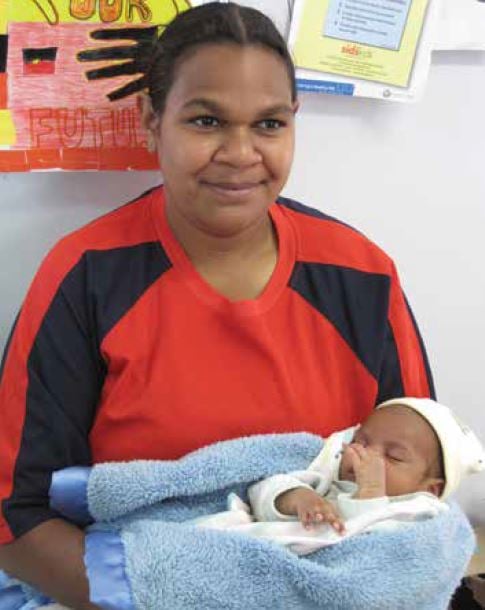
Kadel with his mother, who accessed antenatal care at GRAMS.
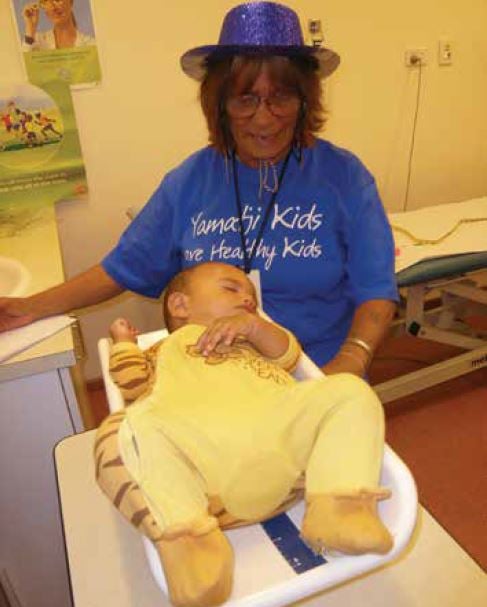
Margie, Aboriginal health worker, and child at a recent child health day held at GRAMS.
Author profiles
Anne-Marie McHugh RGN RM MMid ENB 997, is the State co-ordinator at the Aboriginal Maternity Service Support Unit, Women’s and Newborns Health Service, WA Health/ Aboriginal Health Council of Western Australia.
Rhonda Bradley RN, BSc, RM, M Mid, is the maternal and child health coordinator at the Geraldton Regional Aboriginal Medical Service.
Dr Janet Hornbuckle, FRCOG, FRANZCOG CMFM, is a staff specialist at the Women’s and Newborns Health Service, WA Health, Clinical Senior Lecturer University of Western Australia, Co-Lead Women’s and Newborns Health Network, WA Health.
About the project
The project documents can be obtained by contacting Aboriginal Health Council of Western Australia. Initial Funding Project written by Jessica Stewart and Francine Eades. Project Steering Group: Karen Dunmore, Darryl Kickett, Dr Carmel Nelson, Nicole O Keefe, Glenn Pearson, Anna Sinclair, Craig Somerville. Technical Advisory Group: Dr Sandra Eades, Dr Janet Hornbuckle, Dr Christine Jeffries Stokes, Anne-Marie McHugh.
References
- Hatem M, Sandall J, Devane D, Soltani H. Midwife-led versus other models of care for childbearing women: Cochrane Database of Systematic Reviews 2008. Available from: http://www2.cochrane.org/reviews/en/ab004667.html .
- Coffin J. Rising to the challenge in Aboriginal health with cultural security. Aboriginal and Torres Strait Islander Health Worker Journal,. 2007 May/June 31(2).
- Australian College of Midwives. National Midwifery Guidelines for Consultation & Referral. Canberra, 2008.
- Women and Newborn Health Service. Antenatal Shared Care Guidelines for General Practitioners,. In: King Edward Memorial Hospital, editor. 4th ed: Department of Health ,Government of Western Australia; 2010.
- Council of Australian Governments. Closing the gap: National Partnership agreement on Indigenous Early Childhood Canberra 2009 [cited 2009 0107]; Available from: http://www.coag.gov.au/coag_meeting_outcomes/2009-07-02/docs/NP_indigenous_early_ childhood_development.pdf .
- Royal College of Obstetricians and Gynaecologists. Maternity dashboard- Clinical Performance and Governance score card. London 2008 January 2008.
- Department of Health and Ageing. Healthy for Life Service Toolkit – Section 8: Maternal and Child Health Clinical Audit Tools and Systems Assessment Tool. Canberra Office of Aboriginal and Torres Strait Islander Health 2006 [cited 2009 0109]; Available from: http://www. health.gov.au/internet/h4l/publishing.nsf/Content/toolkit-s8 .



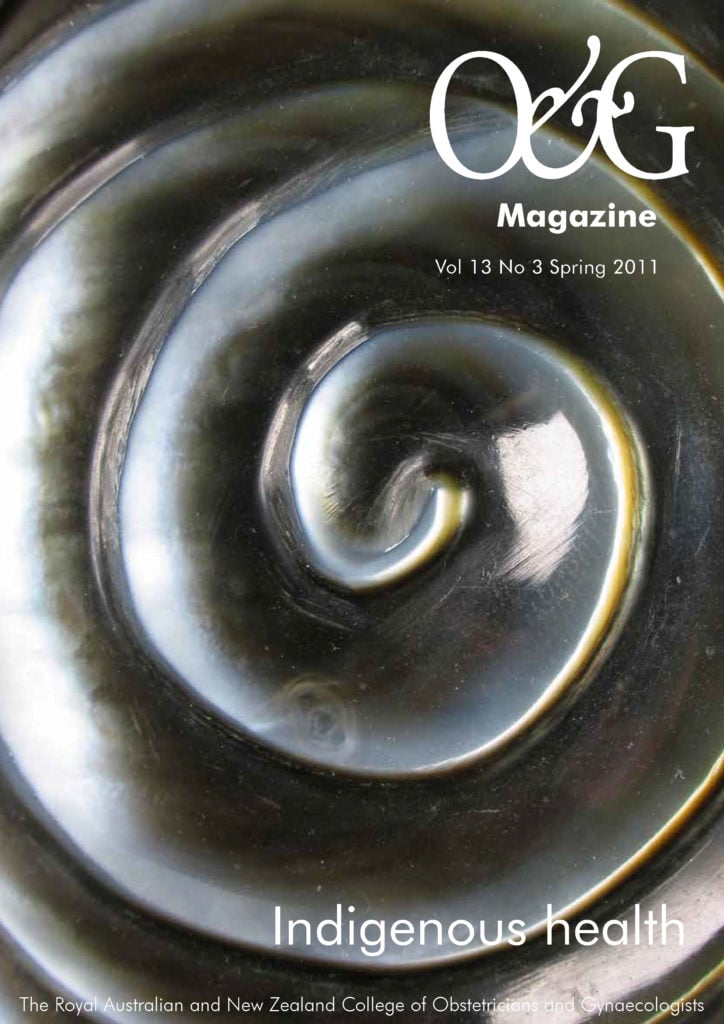

Leave a Reply